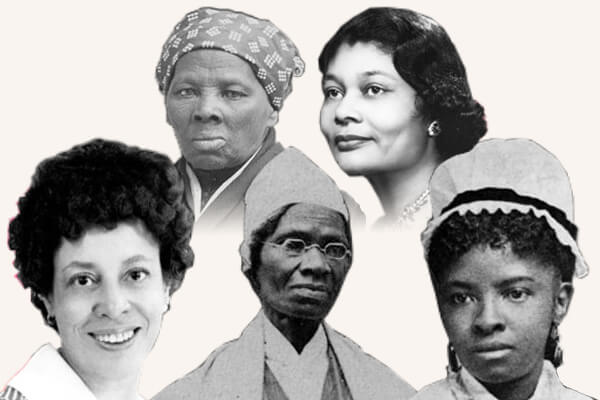Those called to the profession of nursing have an innate sense of empathy, desire to alleviate human suffering, and tenacious drive (some might call it Moxie). Therefore, it comes as no surprise that some of history’s most beloved and iconic figures in the abolition movement began as, you guessed it, nurses. The rich legacy of Black nursing is in fact inseparably intertwined with the Abolition of Slavery, Desegregation, and Civil Rights in the United States.
Acknowledging that there are far too many to name in this article we’d like to offer a history of Black Nurses in America, beginning with Harriet Tubman and Sojourner Truth. We welcome you to dive deeper into this important part of history. The references below are a wonderful place to start.
1826: Sojourner Truth served as a nurse prior to escaping slavery in 1826. She frequently spoke before Congress, advocating for nurse education and training programs.
1840: Harriet Tubman, American Abolitionist famous for her work on the Underground Railroad, used her nursing skills in the Civil War to treat troops with conventional and herbal medicine, and continued her work as a nurse after the war.
1879: Mary Eliza Mahoney becomes the first licensed Black nurse in the United States. Out of her cohort of 42 students, Mahoney was one of just 4 to complete the rigorous, first integrated program at the New England Hospital for Women and Children Training School for Nurses in Boston, MA.
1908: Mahoney establishes the National Association of Colored Graduate Nurses.
1917: During World War I, a small number of Black nurses who were originally rejected from serving in the Army Nurse Corps were asked to enroll due to the flu epidemic which had dramatically reduced the work force and increased patient load. These were the first Black nurses to serve in the armed forces.
1948: Although Black nurses served in World War I and II, it wasn’t until President Truman signed an executive order in 1948 (three years after the end of World War II in 1945) to desegregate the U.S. Armed Forces that Black nurses were officially allowed to serve their country.
1950: After receiving her diploma for nursing in 1938, a Bachelor’s Degree in 1944, and a Master’s Degree in 1948, Lillian Holland Harvey (1912-1994) served as the Dean of Nursing at Tuskegee Institute in Alabama. She held this position for 30 years and with her position, advocated for education and access.
1958: When Martin Luther King Jr. was admitted to the hospital after an attempted assasination, nurse Goldie D. Brangman was on the team at Harlem Hospital that saved his life in emergency heart surgery.
1964: The introduction of Medicare forced desegregation required by the Civil Rights Act in “every hospital in America virtually overnight.” By threatening to withhold federal funding to hospitals that refused to comply, over 1000 hospitals desegregated in four months. While there were indeed struggles, hospitals experienced a comparatively more easeful transition to integration than other institutions because of this firm action.
1971: The National Black Nurses Association is established, as a forum “for black nurses to advocate for and implement strategies to ensure access to the highest quality of healthcare for persons of color,” as their mission.
1972: Eddie Bernice Johnson is the first nurse elected to the Texas State House. In 1986, she was elected to the Texas State Senate.
2020: Dr. Beverly Malone is recognized as a “Living Legend” by the American Academy of Nursing, its highest honor. Her impressive career includes surgical nurse, dean of the School of Nursing at NC Agricultural and Technical University, CEO of the National League for Nursing, and deputy assistant for health with the US Department of Health and Human Services under President Bill Clinton.
In 2022, the field of nursing is led by inspiring medical professionals such as Betty Smith Williams, Dr. Earnest J. Grant, and Sheila Antrum. There is still work to be done to improve diversity (Black Americans account for only 7.5% of the nursing profession compared to 81% of nurses who are white), increase Black Americans’ access to healthcare, and social issues such as microaggressions that persist.
We thank Black Nurses whose efforts have elevated the profession of nursing and continue to improve the field of medicine. And, we honor the compassionate activism towards equality innate within that work.
Written by Vela H. Vaughan
References
https://www.history.com/news/black-nurses-world-war-ii-truman-desegregation-military
https://www.registerednursing.org/articles/african-american-nurses-making-history/
https://galencollege.edu/news/recognizing-african-american-nurses-who-led-the-way
https://www.usnews.com/news/articles/2015/07/30/desegregation-the-hidden-legacy-of-medicare




